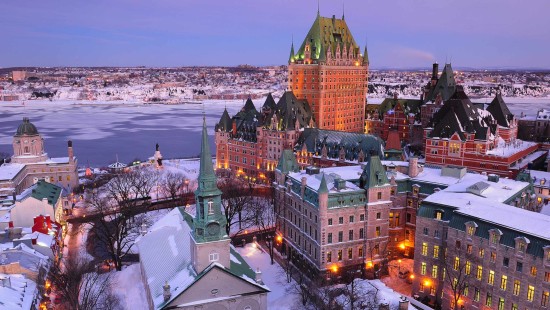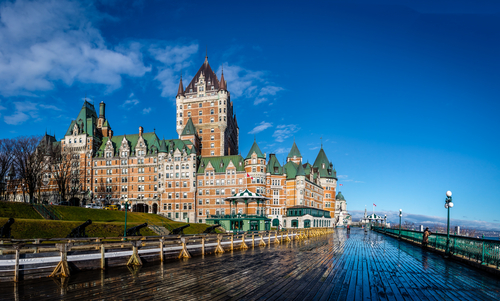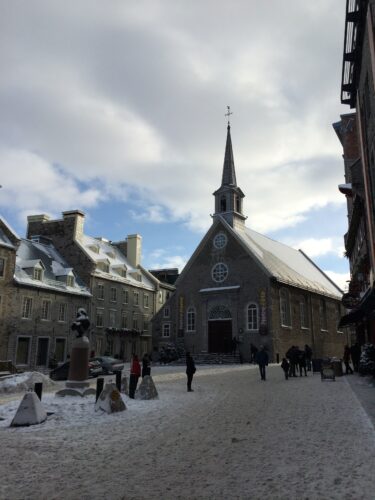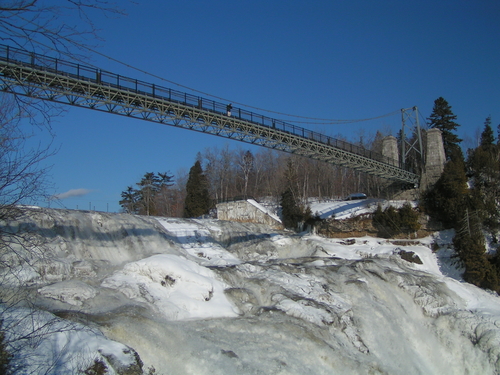
Most New Year’s I find myself in a new city, part of a tradition my husband and I started to see how the world celebrates. And so this year, we decided to give Old Quebec City a try. Rumor had it that the weather could be ridiculously cold. Nevertheless, we packed up our warmest clothes, hopped on a plane and headed north.
Unfortunately, on the day we arrived, a cold air mass swept down from the Arctic driving temperatures down to a frigid 5° F below zero. As we exited the plane, the air sliced into our faces. Our flight attendant shook her head sympathetically. It turned out we were in good company. Even the Canadians were feeling the chill.
ABOUT OLD QUEBEC CITY
Quebec City sits on the banks of the St. Lawrence River and is one of the oldest cities in North America. Founded in 1608 by French settlers, it is the only walled city left in the Americas north of Mexico.

Old Quebec City is a walled city
The older part of the city is referred to as Vieux Québec. European in flavor, it takes its cues from French architecture. There are narrow cobblestoned streets, Catholic churches and countless centuries-old stone and wood houses all built in the New France Style.

Rue du Petit Champlain/Photo: Shutterstock.com
Most people agree that visiting Old Quebec City is like going to Europe without crossing the Atlantic. It even has its own castle! Perched high atop the cliffs of Cap Diamant, the majestic Chateau Frontenac, presides over the city. Opened in 1893, the châteauesque-style building contains an astounding 18 floors and is today the world’s most photographed hotel.

The Chateau Frontenac
With a setting like this, a great vacation seemed certain. And we weren’t disappointed. Following is a recap of our adventures in this beautiful city.
December 30
We awoke on our first morning to temperatures hovering around -5° F. So, we bundled up in everything we brought (which for me included two coats) and joined the holiday throng moving at a brisk pace through the narrow winding streets of the city.
Heading downhill on foot from Quebec’s upper town, we arrived within minutes in the Quartier Petit Champlain, North America’s oldest neighborhood. The area boasts some of the original houses constructed soon after French explorer Samuel de Champlain chose the site in 1608 for New France’s first permanent settlement.

Quartier Petit Champlain/Photo: Shutterstock.com
Today colorful art galleries, boutiques, restaurants and bistros line the quaint neighborhood streets. We stopped briefly in front of Notre-Dame-des-Victoires, a stone church erected in 1688 atop the ruins of Champlain’s first outpost. The one-room church is so named in recognition of how the Virgin Mary, on two separate occasions, protected Quebec City from danger. It presides over the square called Place Royale.

Leaving Quartier Petit Champlain, we headed over to the Musée de la Civilisation. The modern, interactive museum includes a comprehensive history of Quebec with lots of great visuals.

Musée de la Civilisation/Photo: Marc Bruxelle Shutterstock.com
A few steps away in the Terminal des Croisières, we discovered the Parisian-style brasserie, Café du Monde. Located at the top of a grand circular stair, the restaurant is a glittering, mirrored space with banks of windows overlooking the St. Lawrence. We lunched on seafood pot pie (a specialty of the house) and joined a group of raucous diners in lifting a toast to Quebec and the upcoming New Year.
Later, we wound our way back along the cobblestoned streets and up the steep staircase known as ‘L’Escalier Casse-Cou’ (Break Neck Stairs) to the Dufferin Terrace, a half-mile long wooden boardwalk bordering the river. Its namesake, Lord Dufferin, served as governor of Canada from 1872 to 1878. During his tenure, Dufferin fought valiantly against the demolition of the Citadelle. It is thanks to his efforts that the remains of the original fort can still be seen today.

Monument to Lord Dufferin
That evening, we dined at Aux Anciens Canadiens. Located on Rue Saint Louis, the restaurant describes itself as a Bastion of Canadian Country Cooking. The tiny establishment comprises two buildings, one of which dates all the way back to 1675 and the founding of the French Regime.
Specialties of the house include bison, caribou, deer and wapiti, meat pies and Grandma’s original pea soup. Although it was nearly impossible to choose, we finally decided on deer with blueberry sauce and chicken with ratatouille for dinner. After a dessert of homemade vanilla ice cream drizzled with fresh maple syrup, we finished off our evening with shots of vodka and cranberry, a tradition of the house.
NEW YEAR’S EVE IN OLD QUEBEC CITY
On our second day, we awoke to another unbearably cold morning (this time the temperature read -10° F.) Since walking around outside seemed out of the question, we rented a car and headed off to Montmorency Falls. The stunning waterfall is only a few minutes’ drive from Old Quebec City.

Montmorency Falls/Photo: Here By Design
In fact, Montmorency Falls are the largest falls on the Montmorency River and the highest in Quebec. At 275 feet, they measure over 98 feet higher than Niagara. Champlain named them after Henri II, duc de Montmorency, who served as viceroy of New France from 1620 until 1625.
And they are a sight to be seen. Pouring with fury over the top of the cliff, the falls pool in a basin before cascading down into the St. Lawrence River. Defying all logic, we joined a few other brave souls on a windswept, suspended bridge surveying the raging water. We were rewarded with a close-up view of the frothy white jets as they erupted through massive, jigsaw-shaped pieces of ice.

The suspended bridge at Montmorency Falls
Up on the Grande Allée, one of the city’s most popular squares, preparations were underway for a large-scale New Year’s Eve party. As restaurant staff heated up outdoor patios, workers erected a large soundstage and dance floor. A sparkling Ferris wheel towered over one corner of the square.

Old Quebec City’s Grand Allée/Photo: Here By Design
We rang in the New Year with a sumptuous seven-course dinner at Le Patriarche. Located in the heart of the old city next to the Porte Saint-Jean, the charming restaurant occupies a small stone home built in the early 1800’s. The gourmet menu adheres to its executive chef’s “Rule of Three”. That is, each course features savory combinations of flavors in triplet.
Snow was just beginning to fall when the first fireworks began exploding up on the Grande Allée. As the thick white flakes dusted the centuries old architecture, it wasn’t hard to imagine the first settlers enjoying their own New Year’s eves, so many centuries ago.

Old Quebec City/Photo: Here By Design
NEW YEAR’S DAY IN OLD QUEBEC CITY
With the flakes continuing to fall overnight, we awoke on New Year’s Day to a snowstorm though, strangely, the temperature had risen by 20 degrees. The tiny streets were now filled with boisterous crowds in full winter gear, boots crunching on the snow-packed ground. We trudged up the hill to the Chateau Frontenac to partake in the hotel’s renowned afternoon Wine and Cheese Tasting. The popular event takes place in a beautiful circular bar with views out onto the river.

Evening at the Chateau Frontenac/Photo: Here By Design
The lobby teemed with people enjoying the long rows of illuminated trees decorating the hotel hallways. At the cozy bar, we settled into a pair of large leather chairs by the fire. Warmed by the flames, we sampled a selection of local cheeses paired with red wine and sat back to savor the international flavor of the crowd.
Although we hardly had any appetite left at all, we agreed it would be a shame to miss dinner at Le Saint-Amour, considered one of the most romantic restaurants in Quebec. Chef and co-owner Jean-Luc Boulay was voted best chef in Quebec and is famous for his culinary skills with duck foie gras.

Interior of Le Saint-Amour
The ultra-chic restaurant shines with its beautiful and eclectic décor, including a 35’ tall main dining room embellished with glossy red woodwork, gold rococo-style mirrors and original works of art. Enormous planters filled with ferns hang from the ceiling and a large living tree occupies the dining room’s center.
The friendly staff served us an exceptional meal of scallops on Parmesan risotto and Arctic char with crispy shallots; the latter accompanied by Beluga lentils and local vegetables presented in a tiny brass pot. We capped off our final evening in Quebec with the chef’s dessert sampler consisting of miniature macaroons in all flavors, pairs of chocolate domes, mini chocolate ice cream sandwiches on sticks and small goblets of mousse with strawberries.
READY TO GO?
There are so many great restaurants to try in Quebec City as well as cafés and bistros serving top-notch fare. My list is by no means exhaustive and was constricted only by the length of our visit and the size of my waistline. For other great suggestions when planning your next trip go to tripadvisor.com.
This article was updated December 2018. For more information on Quebec City and its many festivals (in all seasons) check out the upcoming Winter Festival in February.
Looking for other great New Year’s ideas in Canada? Check out these top ten places to celebrate at CanadianAffair.com.

